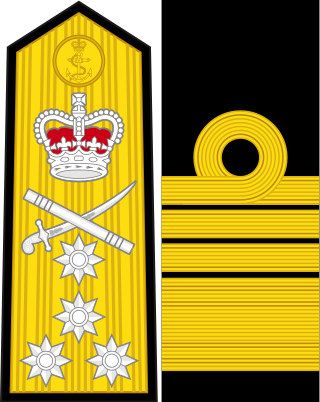Related Research Articles

The Far East Fleet was a fleet of the Royal Navy which existed between 1952 and 1971.

The Home Fleet was a fleet of the Royal Navy that operated from the United Kingdom's territorial waters from 1902 with intervals until 1967. In 1967, it was merged with the Mediterranean Fleet creating the new Western Fleet.

The British Mediterranean Fleet, also known as the Mediterranean Station, was a formation of the Royal Navy. The Fleet was one of the most prestigious commands in the navy for the majority of its history, defending the vital sea link between the United Kingdom and the majority of the British Empire in the Eastern Hemisphere. The first Commander-in-Chief for the Mediterranean Fleet was the appointment of General at Sea Robert Blake in September 1654. The Fleet was in existence until 1967.

The Commander-in-Chief Fleet (CINCFLEET) was the admiral responsible for the operations of the ships, submarines and aircraft of the British Royal Navy from 1971 until April 2012. The post was subordinate to the First Sea Lord, the professional head of the Naval Service. In its last years, as the Navy shrank, more administrative responsibilities were added.

Admiral is a senior rank of the Royal Navy, which equates to the NATO rank code OF-9, outranked only by the rank of admiral of the fleet. Royal Navy officers holding the ranks of rear admiral, vice admiral and admiral of the fleet are sometimes considered generically to be admirals. The rank of admiral is currently the highest rank to which a serving officer in the Royal Navy can be promoted, admiral of the fleet being in abeyance except for honorary promotions of retired officers and members of the royal family.
Commodore (Cdre) is a rank of the Royal Navy above captain and below rear admiral. It has a NATO ranking code of OF-6. The rank is equivalent to brigadier in the British Army and Royal Marines and to air commodore in the Royal Air Force. Commodore has only been a substantive rank in the Royal Navy since 1997. Until then the term denoted a functional position rather than a formal rank, being the title bestowed on the senior officer of a fleet of at least two naval vessels comprising an independent command.

Rear Admiral Józef Czeslaw Bartosik, was a Polish Naval officer who served in Polish destroyers under British naval command during the Second World War. Shortly after the war, he joined the British Royal Navy and advanced to the rank of rear admiral, before his retirement in 1968. He died in England at age 90.

Rear-Admiral of the White was a senior rank of the Royal Navy of the United Kingdom, immediately outranked by the rank Rear-admiral of the red. Royal Navy officers currently holding the ranks of commodore, rear admiral, vice admiral and admiral of the fleet are sometimes considered generically to be admirals. From 1688 to 1805 this rank was in order of precedence eighth; after 1805 it was the ninth. In 1864 it was abolished as a promotional rank..
Rear admiral (RAdm) is a flag officer rank of the Royal Navy. It is immediately superior to commodore and is subordinate to vice admiral. It is a two-star rank and has a NATO ranking code of OF-7.

Admiral Sir Henry Bernard Hughes Rawlings, was a Royal Navy officer who served as Flag Officer, Eastern Mediterranean during the Second World War.

The Reserve Fleet was a Royal Navy formation of decommissioned vessels which could be brought to a state of readiness at time of war.
HMS Rother was a Palmer type River-class destroyer ordered by the Royal Navy under the 1902–1903 Naval Estimates. Named after the River Rother, east of Sheffield, South Yorkshire in England, she was the first ship to carry this name in the Royal Navy.
The Commander in Chief, Dover was an operational commander of the Royal Navy. His subordinate units, establishments, and staff were sometimes informally known as the Dover Command.
In 1989 the Royal Navy was under the direction of the Navy Department in the UK Ministry of Defence. It had two main commands, CINCFLEET and Naval Home Command.
Naval Home Command administered training and garrison functions for the Royal Navy from 1969 to 2012. Its commander was Commander-in-Chief, Naval Home Command (CINCNAVHOME).
The First Flotilla was a naval formation of the British Royal Navy commanded by the Flag Officer, First Flotilla from 1971 to 1990.

The Flag Officer, Second Flotilla was a senior British Royal Navy appointment from 1971 to 1992.

The Flag Officer, Third Flotilla was the senior Royal Navy appointment in command of the Third Flotilla from 1979 to 1992.

The Red Sea Station was a military formation of the Royal Navy. At various times it has also been referred to as Egypt Division and Red Sea and later the Red Sea and Canal Area. The Royal Navy had distinct formations for the Red Sea at intervals from 1846 until circa 1944-45.
References
- ↑ Brown, David; Titterton, G. A. (2013). The Royal Navy and the Mediterranean: Vol.II: November 1940-December 1941. Cambridge England: Routledge. p. 100. ISBN 9781136341205.
- ↑ Admiralty, Great Britain (November 1939). "Flag Officers in Commission". Navy List. London England: HM Stationery Office. p. 238.